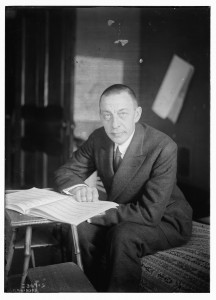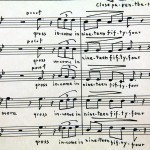Library of Congress's Blog, page 184
September 11, 2012
From Russia, with Music
(The following is a guest article written by my colleague Mark Hartsell, editor of the Library’s staff newsletter, The Gazette, about a two-year project to bring together a Rachmaninoff archive.)
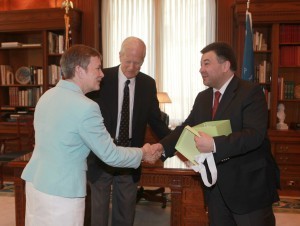
Music Division chief Susan Vita and Librarian of Congress James H. Billington (center) talk with Glinka museum director Mikhail Bryzgalov at the Library in May. / Abby Brack Lewis
The Library of Congress and a Moscow museum recently completed a project that, for the first time, brings together the original music manuscripts of one of the great composers of the 20th century – works that had been separated over the past century by thousands of miles and the Russian Revolution.
The Library and the Glinka National Museum Consortium of Musical Culture between them hold nearly all of the original manuscripts of Russian composer Sergei Rachmaninoff, best known for his great “Rhapsody on a Theme of Paganini,” Piano Concerto No. 2, Prelude in C-sharp Minor and “Vocalise,” among other works.
The institutions digitized their manuscripts over the past two years and, in May, formally exchanged copies in a ceremony at the Library.
The exchange allows musicians and scholars, for the first time, to study the composer’s manuscripts side by side.
“Our ultimate goal in entering into this project was to make these important research materials as accessible as possible to researchers and performers,” said Jan Lauridsen, assistant chief of the Library’s Music Division.
Insights for Musicians
The study of original manuscripts allows musicians and scholars to gain insight into compositions and the methods of their creators – decisions, for example, on omissions, additions and revisions.
The work of Norwegian pianist Leif Ove Andsnes serves as a case in point.
Andsnes this year received a nomination for a Grammy Award for his recordings of Rachmaninoff’s third and fourth piano concertos – a project for which he prepared by studying the composer’s scores and sketches at the Library.
Rachmaninoff debuted his Piano Concerto No. 4 in 1927 to generally bad notices – reviews that prompted the composer to cut and revise the piece several times over the next 14 years.
“I thought it was very fascinating that there were big chunks of music that were just taken away in the 1941 version,” Andsnes said. “I wanted to look at the score and compare it to the other two versions and see what the process was for Rachmaninoff and figure out what he tried to do and why. That was wonderful to sit with these different versions.
“When you look at the manuscript, you often see the energy of how it is composed. You see the insecurities – things have been crossed out – and other suggestions. It’s very interesting to see that process.”
Rachmaninoff composed the bulk of his work in the late 19th and early 20th centuries before he fled his native Russia for the West following the Russian Revolution in 1917.
He composed several important works – Piano Concerto No. 4 and “Rhapsody on a Theme of Paganini,” among them – over the next quarter-century while he lived in New York, California and Switzerland.
Rachmaninoff died in 1943 in California, and his widow, Natalie, began donating his post-Russia archive to the Library eight years later.
The Glinka, meanwhile, eventually acquired the manuscripts from the composer’s Russia years.
The collaboration between two institutions separated by thousands of miles brings together complementary pieces of Rachmaninoff’s work – early sketches he made in Russia but turned into completed works years later in the West, revisions to early works that the composer made later in the United States or Switzerland.
For example, Rachmaninoff made early sketches of “Rhapsody on a Theme of Paganini” in Russia, sketches now held by the Glinka. He finished the piece in 1934 while living in Switzerland, and the full score of the completed work resides in the Library.
The manuscript exchange allows musicians and scholars, finally, to make a side-by-side study of the versions of this great work – its 18th variation provides one of the best-known themes in classical music – from the earliest inspirations Rachmaninoff captured on paper to the full score.
For now, the material is not accessible online – most of the Library’s holdings of Rachmaninoff are not yet in the public domain – but it is available to researchers who visit the Library or the Glinka.
The opportunity to study the original manuscripts and digital versions of the originals in one location is irreplaceable, Andsnes said.
“When you sit with the actual manuscript,” he said, “there is a kind of a holy feeling of touching this paper that the composer has been working with – that’s magic.”
September 10, 2012
Last Chance!
Two exhibitions from the Library of Congress are closing this month, so if you’re about town, now is your chance to check them out before they are gone.
“Sakura: Cherry Blossoms as Living Symbols of Friendship” closes Sept. 15 in the Graphic Arts Galleries. The Library opened the exhibition in celebration of the 100th anniversary of the gift of 3,000 flowering cherry trees (“sakura” in Japanese) as a symbol of enduring friendship between Japan and the United States.
The Inside Adams blog in March posted a great story on the history of the Japanese flowering trees and their ties to the U.S.
On Sept. 26, “To Know Wisdom and Instruction: The Armenian Literary Tradition at the Library of Congress” closes in the South Gallery. The exhibition marks the 500th anniversary of Armenian printing and UNESCO’s designation of Yerevan – the capital of the Republic of Armenia – as its Book Capital of the World, 2012. You can read more about it here.
Both exhibitions are located in the Library’s Thomas Jefferson Building and open from 8:30 a.m. to 4:30 p.m. every day except Sunday.
If you can’t stop by and see them in person, you can check them out online:
The Armenian Literary Tradition at the Library of Congress
September 7, 2012
In Retrospect: August Blogging Edition
The Library of Congress blogosphere in August was full of great posts from our many expert curators and staff. Here is just a sampling:
In the Muse: Performing Arts Blog
The Musical Worlds of Victor Hebert
On Aug. 16, the Library opened a new exhibition on composer Victor Herbert.
The Signal: Digital Preservation
Digital Preservation Depicted in (Weirdly) Varied Images
Digital preservation is viewed through the lens of popular culture.
Picture This: Library of Congress Prints & Photos
Child Labor Photos – What Do Children See?
Photos from the Library’s National Child Labor Committee (NCLC) get a little youthful input from the children of curator Barbara Orbach Natanson.
From the Catbird Seat: Poetry & Literature at the Library of Congress
Rob Casper, director of the Library’s Poetry and Literature Center, talks about the legacy of the Poetry Office.
Inside Adams: Science, Technology & Business
An Early History of Life Insurance
2012 Junior Fellow Alec Torte gives a history of the New England Mutual Life Insurance Company.
In Custodia Legis: Law Librarians of Congress
Legal Pirates, Treasure and Murder: A Tale from the South Seas
Kelly Buchanan, chief of the Foreign, Comparative and International Law Division I, discusses the legal angles of a sunken ship and its treasure from 1806.
Teaching with the Library of Congress
Ten Tips to Start the Year with Primary Sources
Here are some ideas from teachers and librarians for ways to use the Library’s primary sources in the classroom.
Copyright Matters: Digitization and Public Access
Current Copyright Search Capability: Tell Us What You Think
Who wants to know? Copyright wants to know what users like and don’t like about their existing online search functionality for copyright records.
September 5, 2012
Rock the Vote
(This is the second in a series of posts featuring presidential campaign items from the Library’s collections. Read the first here. )
Politics and music have enjoyed a rather persistent relationship. And it’s never more evident than during campaign season when candidates use music to connect with voters. The tradition can be seen as far back as the presidential election of George Washington, although he was uncontested.
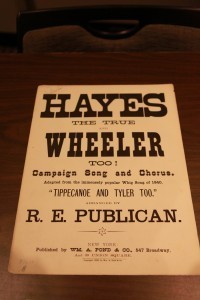
"Hays the True and Wheeler Too!" 1876. Music Division.
Often set to popular songs of the day, during the early 19th century, most tunes were in celebration of the candidate and not necessarily about campaign issues. It wasn’t until the election of 1840 that the songs became issue-based and were really used to try to affect the outcome of an election. During this time, partisan politics was well developed, and the Democrats and Whigs – the two major parties of the day – used the power of song as a campaign tool.
One of the best-known campaign songs was inspired by William Henry Harrison: “Tippecanoe and Tyler Too” touted Harrison as a war hero at the 1811 Battle of Tippecanoe, and his vice president, John Tyler. The “media blitz” that resulted sang Harrison into his presidency.
Both parties also published “songsters,” pocket-sized books perfect for an impromptu street corner rally. The earliest songsters included only lyrics printed along with the titles of well-known tunes to which they were to be sung. Two songsters from the 1844 contest between James K. Polk (1795–1849) and Henry Clay (1777–1852) offered their followers relevant new words for old standards like “Yankee Doodle.” By 1884, some songsters would include written music arrangements, including the “Blaine-Logan Songster” that served to promote a specific ticket.
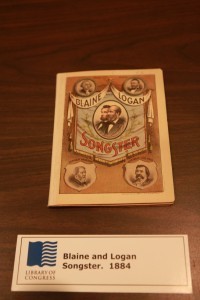
Blaine and Logan Songster. 1884. Music Division
These songs connected with voters through their leisure activities. Families would buy the music and sing the songs together.
So, who wrote these songs? Writers were often hired by the campaign to put together something catchy that would stick with voters so they would remember the candidates’ names – “We Like Ike.” Well-known musicians were also sometimes enlisted to compose a ditty: “Harding You’re the Man for Us” (1920) was written and sung by Al Jolson; Ira Gershwin reworked “It Ain’t Necessarily So” from “Porgy and Bess” for Adlai Stevenson in 1952.
By the last quarter of the 20th century, political parties turned more and more to newspapers, radio and television, which provided immediate access to mass audiences. Increasingly, candidates began to adopt existing songs from popular recording artists as their own. Although composers still wrote music in celebration of their favorite candidates, sheet music became less and less significant in campaigning.
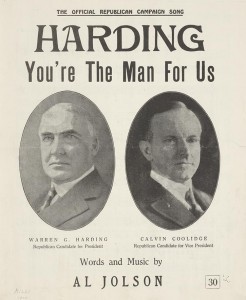
Al Jolson. “Harding You’re the Man for Us.” New York: Al Jolson, 1920. Music Division
Make sure to check out the Library’s online exhibition, “Voices, Votes, Victory: Presidential Campaign Songs,” for more.
August 23, 2012
See It Now: Take Your Pick
So many great webcasts are being added to the Library of Congress website daily, that it has become hard to pick just one to feature, as I’ve done in the past. And, the programming here at the institution is so diverse, you’re sure to find something of interest.
Here is just a sampling of some of the webcasts recently added:
History of the Guide Dog Movement
Jane Sheehan and Don Olson discussed the history of the guide dog movement, the trends of the movement today, and how the movement impacts both blind and sighted communities.
Nobel Laureate Herta Muller
The Library of Congress, in collaboration with the Goethe-Institut, presented a reading and discussion with Nobel Laureate Herta Muller, winner of the Nobel Prize in Literature in 2009.
In Search of Sacco and Vanzetti
Journalist Susan Tejada spent years in the Library of Congress and elsewhere investigating the case or anarchists Nicola Sacco and Bartolomeo Vanzetti and presented her research in this lecture.
Persian Traditional Music Project
This illustrated lecture revealed the background and importance of Golha radio programs which were broadcast in Iran from 1956 through 1978. Jane Lewisohn discussed the artistic, literary and social significance of preserving and promoting Persian literature and music in general.
So you don’t miss out on anything, make sure to subscribe to the RSS feed or email service for Library webcasts under the Library Website Updates heading.
August 21, 2012
Curator’s Picks: Fab Five
The collections of the Library of Congress are vast and varied. And, what better way to get to know them but through our many wonderful curators. In this inaugural edition of “Curator’s Picks,” jazz curator Larry Appelbaum discusses a few prized items housed in the Music Division.
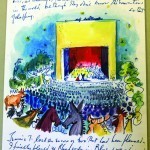 A hand-written letter from Leonard Bernstein to his mother in 1948 documents the 30-year old composer and conductor’s first trip to the newly formed state of Israel. In the midst of war, he writes about his adventures and passions for the land and the people.
A hand-written letter from Leonard Bernstein to his mother in 1948 documents the 30-year old composer and conductor’s first trip to the newly formed state of Israel. In the midst of war, he writes about his adventures and passions for the land and the people.
“The letter is beautifully illustrated by his friend, the artist Jossi Stern,” said Appelbaum.
In 1955, trumpeter, singer and entertainer Louis Armstrong participated in a sociological survey about jazz musicians and the use of habituating drugs.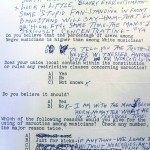
“Armstrong’s hand-written response reveals much about his insight, mother wit and humanity.”
Composer Avery Claflin (1898-1979), who was known in professional circles as a lawyer, banker and President of the French-American Banking Corporation, composed this madrigal titled “Lament for April 15.”
“It includes text taken from the 1955 Internal Revenue Service tax form.”
Composed by George Gershwin for a 1924 Aeolian Hall concert by Paul Whiteman and his Palais Royal Orchestra, “Rhapsody in Blue” combines elements of classical music with the flavor of jazz. Pictured to the right is Ferde Ferde Grofé’s holograph orchestration of one of the most famous American concert works.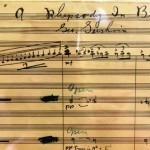
“On the first page of the score is the famous trill and glissando played that night by virtuoso clarinetist Ross Gorman. There are also blank portions in the score where the piano soloist, Gershwin himself, played but didn’t have time to write out his part.”
The Library’s collection of work by the celebrated jazz photographer William P. Gottlieb includes this 1947 image of jazz great Dizzy Gillespie making goo-goo eyes at “First Lady of Song.”
“All 1,600 images in the Library’s Gottlieb Collection are in the public domain and available for download.”
(You can view the collection here.)
August 14, 2012
In Retrospect: July Blogging Edition
Here’s a roundup of what’s been going on in the Library of Congress blogosphere in July.
In the Muse: Performing Arts Blog
Pat Padua connects composer Ernst Bacon to Kevin Bacon, among others.
The Signal: Digital Preservation
One Family’s Personal Digital Archives Project
Mike Ashenfelder relates the story of Vernon James and his son James.
Picture This: Library of Congress Prints & Photos
Celebrate Sparkling New FSA Scans
New photos in the Farm Security Administration Collection have been digitized.
From the Catbird Seat: Poetry & Literature at the Library of Congress
Sagan’s Papers Offer a Window into His Literary Pursuits
Carl Sagan’s papers include his reading list.
Inside Adams: Science, Technology & Business
A Fortune Made from Fur: John Jacob Astor
Ellen Terrell gives a brief biography of the businessman.
In Custodia Legis: Law Librarians of Congress
180th Anniversary of the Law Library of Congress
The Law Library celebrates a milestone.
Teaching with the Library of Congress
Sharing Summer Teacher Institute Discoveries
Visiting teachers make collection discoveries.
August 10, 2012
Library in the News: July Recap Edition
Leading the news headlines in July was the conveyance of the $1 million John W. Kluge Prize for the lifetime achievement in the study of humanity to Fernando Henrique Cardoso, former president of Brazil. He was honored in an awards ceremony for his study of the social structures of Brazilian government, economy and race relations and its transformation from a military dictatorship to a democracy.
Cardoso spoke with Washington Post reporter Eva Rodriquez.
Young people have dreams. My dream was to learn how to devote my time and my energy in creating a better Brazilian society,” he said.
When I remember as a child in Rio, on Copacabana Beach, in Rio, it was also a very backward country,” Cardoso told Jeffrey Brown of PBS Newshour. “And now I can see a much more dynamic society in Brazil. And now we have democracy. Now we have people asking for more. Now we have protests. Now we have the free press. Now we have universities. Now we have contacts across the globe. My God, it was an enormous progress.”
Other outlets featuring stories included the Associated Press (AP), WTOP, América Latina and other international outlets.
The Washington Post also did a feature story on a special, private display for members of Congress on the history of U.S. presidential elections, culled from the several collections in the Library. Reporter Michael Ruane called the items “attention getting.”
CNN ran a video piece as part of its State of the Union with Candy Crowley program.
In appy news, the Library has added to its Apple offerings with new applications for the Congressional Record and its new digital collection of Aesop’s Fables (also available online). Running announcements were the Washington Post, WTOP and Education Week.
Several of the Library of Congress’ previously announced initiatives continued to make news in July, including its list of “books that shaped America.”
An interesting take on the book list was featured by the Chicago Tribune, which looked at the cookbooks included in the influential tomes.
“It’s [the list] meant to start a conversation,” said reporters Judy Hevrdejs and Bill Daley. “And it did when we came upon the cookbooks on the list, each a reflection of their times.”
The two highlighted “American Cookery” (1796), by Amelia Simmons, “The American Woman’s Home” (1869), by Harriet Beecher Stowe and Catharine E. Beecher and “Joy of Cooking” (1931) by Irma Rombauer.
Also still in the headlines was the Library’s initiative marking the 150th anniversary of the Morrill Act.
Brett Zongker’s article for the Associated Press highlighted the history of the law that would establish a network of land-grant universities. Librarian of Congress James H. Billington ranked the movement as one of the great milestones in American history.
The Denver Post, Boston Globe and the Southeast Missourian were among the outlets carrying the story.
The Library conducted week-long Teacher Institutes in July to promote the use of primary sources in the classroom. Community newspapers far and wide ran stories of local teachers who participated in the program. Teachers came from California, Illinois, Ohio, Kentucky, Pennsylvania, Michigan, Florida, Virginia and Alaska, to name a few.
August 6, 2012
Fear and Desire
I was reading an article the other day on the possibility of a prequel to “The Shining” (1980), Stanley Kubrick’s adaptation of the Stephen King novel. Apparently, the project is in its early stages of development but would focus on what happened at the haunted Overlook Hotel before the Torrance family arrived. While I’m not sure how I feel about that idea, I can say the original movie, starring Jack Nicholson, was a disturbing one. Frankly, I love horror movies, and the ones that have a psychological bent, like “The Shining,” always get me. Noted director Martin Scorsese ranked the film as one of the 11 scariest of all time.
“The Shining” certainly isn’t the only film of Stanley Kubrick’s that has provoked, mesmerized and entertained moviegoers for decades. “A Clockwork Orange” (1972) and “2001: A Space Odyssey” (1968) are illustrative of a body of work that explored and pushed multiple genres to unforgettable effect.
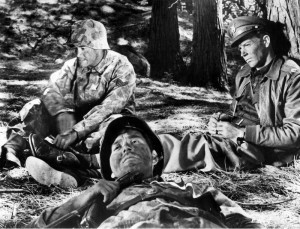
Credit: Kino Lorber
Now, the Library’s Packard Campus for Audio Visual Conservation in Culpeper, Va., has restored Kubrick’s first feature-length film, “Fear and Desire” (1953), which foreshadows his later war-themed works “Full Metal Jacket” (1988) and “Paths of Glory” (1957). The film, which follows a squad of soldiers who have crash-landed behind enemy lines and must work their way downriver to rejoin their unit, has rarely been shown since its original release.
Kino Lorber Inc. will make the restored film available for sale on Blu-ray and DVD in October.
The restoration of “Fear and Desire” is among the most recent illustrations of the Library’s efforts to ensure America’s audio-visual legacy is preserved for future generations. Some of the institution’s other major preservation projects include “All Quiet on the Western Front” (1930), “Mr Smith Goes to Washington” (1939), “The Emperor Jones” (1933), and the pre-release version of “Baby Face” (1933).
The Library’s Packard Campus acquires, preserves and provides access to the world’s largest and most comprehensive collection of motion pictures, television programs and sound recordings. It is home to more than 6 million collection items and provides support for the Library of Congress National Film Preservation Board and the National Film Registry.
And, Kubrick has a pretty solid presence on the film registry. In addition to “Paths of Glory” (named in 1992) and “2001: A Space Odyssey” (named in 1991), 1964′s “Dr. Strangelove or: How I Learned to Stop Worrying and Love the Bomb” was named to the inaugural Registry list in 1989.
August 2, 2012
Keep the Ball Rolling
(This is the first in a series of posts featuring presidential campaign items from the Library’s collections.)
In Washington, there’s always a time and place to talk politics, even more so in an election year. Today we get televised speeches and conventions, commercials, celebrity endorsements and citizens proudly showcasing their candidate choice through stickers, buttons, car decals and t-shirts.
Our political forebears weren’t beyond their own pomp and circumstance, albeit not televised ones. As a publicity stunt in the 1888 presidential campaign, supporters of Benjamin Harrison rolled a huge ball covered with campaign slogans halfway across the country.
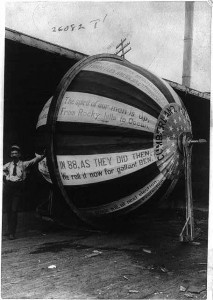
Benjamin Harrison campaign ball, 1888 / Prints and Photographs Division
Inscribed on the ball was:
“Old Allegany in 1840 started the ball for Harrison; In ’88 as they did then, We roll it on for Gallant Ben. Roll along, Roll away, Keep the ball in motion; The spirit of our men is up from Rocky Hills to Ocean.”
The ball was a replica of one built for Harrison’s grandfather, William Henry Harrison, for his 1840 presidential campaign. The gimmick gave rise to the phrase, “Keep the ball rolling.”
D. E. Brockett of Cumberland, Md., built the steel-ribbed and canvas-covered sphere and rolled it approximately 5,000 miles and several states to Benjamin Harrison’s home state of Indiana.
Harrison, a republican, challenged democrat and sitting president Grover Cleveland in the 1888 presidential election. Harrison lost the popular by a narrow margin but became president by winning in the Electoral College.
Typical of the era, neither candidate hit the campaign trail themselves, although Harrison conducted a successful “front porch” campaign from his Indianapolis home, helping him win the key states of Indiana and New York.
Cleveland would turn around and defeat Harrison in the 1894 presidential election making him the first president to serve two nonconsecutive terms in office.
Library of Congress's Blog
- Library of Congress's profile
- 74 followers


